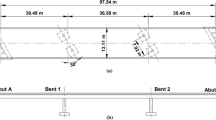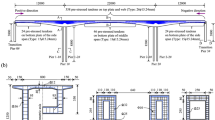Abstract
This paper tried to analyze the behavior of a typical bridge and the effect of its skew degree on its behavior to near-field earthquakes. To this end, the seismic behavior of a number of typical bridges with same spans and different skew degrees was studied under near-field and far-field earthquakes. Non-linear static analyses (pushover analyses) were performed to determine the performance parameters of the bridge in each model. Non-linear time history dynamic analyses were also performed on the models to analyze the dynamic behavior and deformations of bridge components under near-field and far-field earthquakes. The responses of models, such as their displacement, base shear, and axial forces of columns to earthquakes under study are presented in the following sections. Results indicated that the base shear and displacement of the superstructure in near-field earthquakes without velocity pulse and far-field earthquakes are about or less than the corresponding values of the bridge performance point. Moreover, in the case of near-field earthquakes with velocity pulses the values of these parameters showed an increase. It was also revealed that an increase in the skew degree of the bridge led to an increase in the axial forces in columns and transverse displacement of the bridge.













Similar content being viewed by others
References
Orozco GL, Ashford SA (2002) Effects of large velocity pulses on reinforced concrete bridge columns. Pacific Earthquake Engineering Research Center, College of Engineering University of California, Berkeley
Moustafa A, Takewaki I (2010) Deterministic and probabilistic representation of near-field pulse-like ground motion. Soil Dyn Earthq Eng 30:412–422
Jennings PC, Housner GW, Hudson DE, Trifunac MD, Frazier GA, Wood JH et al (1971) Engineering features of the San Fernando earthquake of February 9, 1971, Report no. EERL 71-02. Pasadena (CA)
Buckle IG (1994) The Northridge. California earthquake of January 17, 1994: performance of highway bridges, Report no. NCEER-94-0008. Buffalo, New York
Wilson T, Chen S, Mahmoud H (2015) Analytical case study on the seismic performance of a curved and skewed reinforced concrete bridge under vertical ground motion. Eng Struct 100:128–136
Kaviani P, Zareian F, Taciroglu E (2012) Seismic behavior of reinforced concrete bridges with skew-angled seat-type abutments. Eng Struct 45:137–150
Brown A, Saiidi MS (2011) Investigation of effect of near-fault motions on substandard bridge structures. Earthq Eng Eng Vib 10(1):1–11
Hall JF, Heaton TH, Haling MW, Wald DJ (1995) Near source ground motion and its effects on flexible buildings. Earthq Spectra 11:569–606
Docilely M (2008) Performance of seismic-isolated bridges with and without elastic- gap devices in near-fault zones. Earthq Eng Struct Dyn 37:935–954
Jonson MH, Bessason B, Haflidason E (2010) Earthquake response of a base-isolated bridge subjected to strong near-fault ground motion. Soil Dyn Earthq Eng 30:447–455
Malhotra PK (1999) Response of buildings to near-field pulse-like ground motions. Earthq Eng Struct Dyn 28:1309–1326
Kikuchi M, Dan K, Yashiro K (2000) Seismic behavior of a reinforced concrete building due to large vertical ground motions in near-source regions. In: 12th world conference on earthquake engineering, Auckland, New Zealand, No. 1876
Iwan WD (1995) Near-field consideration in specification of seismic design motions of structures. In: 10th European conference on earthquake engineering, Balkema, Rotterdam, pp 257–267
Somerville P (1997) the characteristics and quantification of near fault ground motion. In: Proceedings of the FHWA/NCEER Workshop on the national representation of seismic ground motion for new and existing highway facilities, Burlingame, California
Bertero VV, Mahin SA, Herrera RA (1987) A seismic design implications of San Fernando earthquake records. Earthq Eng Struct Dyn 6(1):31–42
Anderson JC, Bertero VV (1987) Uncertainties in establishing design earthquake. J Struct Eng 113(8):1709–1724
Ghodrati GR, Razeghi HR, Davoudi ART (2011) The effect of fling step and forward directivity on the seismic response of MSSS bridges. Transp Res J 1:32–40
Chopra AK, Chintana-pakdee C (2001) Comparing response of SDOF systems to near-fault and far-fault earthquake motions in the context of spectral regions. Earthq Eng Struct Dyn 30:1769–1789
Liao WI, Loh CH, Wan S, Jean WY, Chai JF (2000) Dynamic responses of bridges subjected to near-fault ground motions. J Chin Inst Eng 23(4):455–464
Liao WI, Loh CH, Lee BH (2004) Comparison of dynamic response of isolated and non-isolated continuous girder bridges subjected to near-fault ground motions. Eng Struct 26:2173–2183
Tajammolian H, Khoshnoudian F, Partovi Mehr N (2016) Seismic responses of asymmetric structures isolated with the TCFP subjected to near-fault ground motions. IJCE 14(8):573–584
Vafaie J, Taghikhany T, Tehranizadeh M (2011) Near field effect on horizontal equal-hazard spectrum of Tabriz city in north-west of Iran. IJCE 9(1):49–56
Standard No.139 (2005) Iranian standard loads for bridges, 3rd Edition, Tehran, Iran
AASHTO HB-17 (2002) Standard specifications for highway bridges, 17th edn. American Association of State and Highway Transportation Officials, Washington, DC
Computers and Structures Inc.(CSI)., “SAP 2000”: Integrated Finite Element Analysis and Design of Structures, Berkeley, CA
Aviram A, Mackie KR, Stojadinovic B (2008) Guidelines for nonlinear analysis of bridge structures in California. In: Pacific Earthquake Engineering Research Center University of California Berkeley, CA
ATC-32 (1996) Improved seismic design criteria for California bridges. Applied Technology Council, Redwood City, California, Report No. ATC-32
Caltrans (2004) Seismic design criteria, Version 1.3, California Department of Transportation, Sacramento, CA
Author information
Authors and Affiliations
Corresponding author
Rights and permissions
About this article
Cite this article
Ebrahimi Motlagh, H.R., Rahai, A. Dynamic Response of a Continuous-Deck Bridge with Different Skew Degrees to Near-Field Ground Motions. Int J Civ Eng 15, 715–725 (2017). https://doi.org/10.1007/s40999-017-0169-8
Received:
Revised:
Accepted:
Published:
Issue Date:
DOI: https://doi.org/10.1007/s40999-017-0169-8




